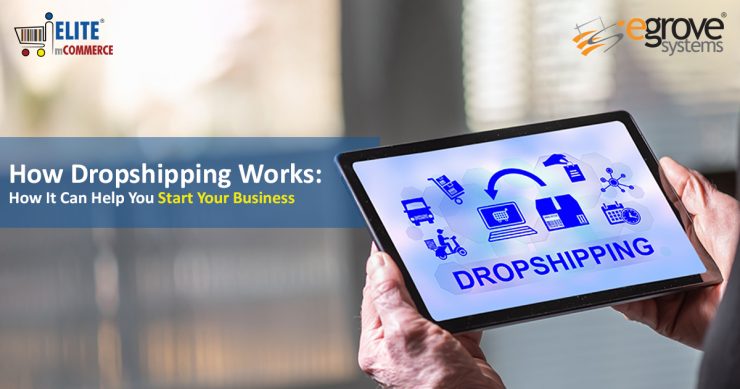Starting an eCommerce store requires massive investments in warehouse leasing, supply chain handling, inventory management, and shipping costs. Such gargantuan costs can prevent even the most zealous people from building their own online businesses. But, all hope is not lost because there is another option for online retailers to meet the demand of their customers: dropshipping. What is it all about, and how can your business gain from dropshipping? Let us find out!
Dropshipping: Definition and Overview
In simple terms, drop shipping can be defined as an online retail business model wherein the retailer is not mandated to maintain an inventory of the items they are selling. It is a non-conventional order fulfillment model mostly co-opted by eCommerce ventures wary of inventory stocking and management. Instead, the retailer purchases inventory as and when required from a third party, which is usually a wholesaler or manufacturer, to fulfill its orders.
The main difference between dropshipping and the standard retail business model is that the in the former structure, the selling merchant does not stock or own the inventory; they act as intermediaries. Currently, the global dropshipping market is valued at USD 225.99 billion and is expected to grow at a CAGR of 23.4 percent from 2023 to 2030. Thus, if you have a business idea brewing in your mind but are turned off by the thought of maintaining and paying for a storefront and other overheads, dropshipping could be the optimal solution.
The Dropshipping Business Model: A Breakdown
In the dropshipping business model, the seller accepts customer orders without keeping an in-hand stock of items. Instead, the online seller transfers the order and its shipment details to a third-party manufacturer, wholesaler, or fulfillment house through supply chain management. Then, the third-party manufacturer supplies the goods directly to the customer. Thus, the online retailer is solely responsible for marketing and selling the product with little to no control over product quality, storage, inventory management, and shipping.
The culmination is the elimination of all the costs pertaining to warehouse management, purchasing and storing inventory, and employing staff for necessary functions. Thus, dropshipping is a win-win situation for both retailers and third-party suppliers, as both of them can focus on the business processes they specialize in. The online seller can foster customer relationships, whereas the supplier maintains inventory and ships products. Dropshipping is a global phenomenon, and 23 percent of all online sales are dropshipping ones.
Five Ways by Which Dropshipping Helps Kickstart Your Business
Dropshipping can benefit entrepreneurs or upcoming businesses that are wary of the costs involved in setting up a full-fledged manufacturing, inventory, and warehousing set-up, owing to price constraints and the precarious nature of the market. As such, dropshipping can emerge as an alternative business model that helps in the following ways –
- Less Capital Requirement
One of the main reasons dropshipping is favorable for small businesses is that it enables launching an eCommerce store without investing hundreds of thousands of dollars in inventory. With the dropshipping model, the online seller does not have to purchase a product until the sale is already made and the customer pays the money. In addition, as you are not selling products through any inventory purchased upfront, there is less risk of failure in dropshipping. Thus, drop shipping is a cost-effective and risk-free method to kickstart an enterprise and be successful.
- Easy to Handle
Operating an online business becomes much easier when physical products are not handled. Thus, with dropshipping, you do not have to deal with tangible items and other aspects of business, such as
- Managing and paying for the warehouse
- Order fulfillment,
- Inventory management, and
- The processing of returns and incoming shipments.
- Continuous order of products
- Managing stock level and more
- Minimal Overhead Costs
The third way dropshipping can help kickstart your business is through overhead cost minimization. As a dropshipping enterprise, you do not have to purchase inventory, manage order fulfillment centers, or hire staff to do the same. Thus, the overhead costs are quite low. In fact, most dropshipping stores are successfully manned at home, requiring little more than a laptop and a few recurring expenses for operations. Of course, the overhead costs will inflate as the business grows, but they will still be compared to the traditional trajectory.
- Better Scalability
Under the traditional business model, a surge in demand or customer orders is complemented by increasing workload and further monetary investment in scaling the physical premises and workers of the enterprise. On the contrary, dropshipping is an incredibly scalable business. By leveraging dropshipping suppliers, you ensure that the suppliers do most of the work pertaining to additional order processing. Thus, your business gets bigger with less pain and more gains.
- Geographical Flexibility
Last but not least, you can run a successful dropshipping business from any corner of the world. All you need is a stable internet connection to communicate with the suppliers and offer timely service and support to the customers. Thus, even if you shift to a different part of the world, the dropshipping business can keep growing by leaps and bounds.
So, there we have it, a crisp overview of what dropshipping is all about and how businesses can leverage the mode for increased success and profitability.









Add comment